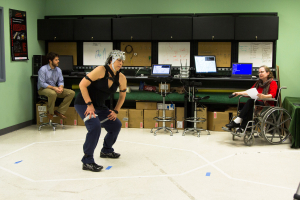Karen Studd is a professional dancer, devoting much of her waking hours to practicing and perfecting her discipline. And today is no different – she is moving slowly, methodically, gracefully across the room with such softness it’s as if she’s a ghost, weightless and transparent. In a room full of silent spectators, all eyes are on Studd as she dances her way across the room.
Studd, a tenured professor of dance at George Mason University, is no stranger to this type of performance. But there’s something different about today’s rendition: Studd is donning an EEG brain cap which records her brain signals and inertial sensors that record her body movement while she dances, her performance is taking place inside of a research laboratory, and her audience is comprised of student and faculty researchers from the UH Cullen College of Engineering.
This is more than just another dance performance for Studd – this is groundbreaking research on the effects that dancing has on the brain, and she has been chosen to play the starring role in this pilot study titled “Your Brain on Dance: The neural symphony of expressive movement.”
In a unique collaboration between the University of Maryland’s Department of Dance and the University of Houston’s Laboratory for Noninvasive Brain-Machine Interface (BMI) Systems, dancers and engineers are teaming up to learn more about what goes on inside the brain when one dances - the 'neural symphony' of expressive movements.
Funded by an ADVANCE grant from the National Science Foundation, Karen Bradley, head of the dance program at the University of Maryland, joined forces with ECE professor Jose “Pepe” Contreras-Vidal. They first met in 2011 when they collaborated on a demonstration at the Kennedy Center for the Performing Arts in Washington DC to visualize brain activity during dance. Since much of Pepe’s research focuses on the development of noninvasive tools for recording brain signals – such as his EEG skull cap, which looks much like a swimmer’s cap dotted with electrodes – this partnership between dancer and engineer seemed only natural.
The hope is that this research will shed some light on brain-wave patterns associated with particular expressive movement. Once researchers obtain a better understanding of the brain signals associated with expressive dance, they may also gain insight into the therapeutic implications of dance and the movement arts.
Moreover, Pepe hopes this study will help inform some of his own research on the development of lifelike robotic limbs and exoskeletons for paralysis patients.
“The results of this research will inform important breakthroughs in identifying the components of individual human personality, which will help with communicating emotion and expression in fields like robotics, artificial limbs and animation,” Pepe and Karen explained. “Our hope is that, one day, this research will help inform how avatars could eventually express what a physically and/or neurologically-compromised individual is trying to communicate.”
After analyzing their pilot data, they plan to submit a collaborative grant to the National Science Foundation to transform the way that engineering and the performing arts can learn from each other while uncovering solutions to some of the most devastating challenges of physical and neurological disability in the world.
To learn more about this research, please visit here.
